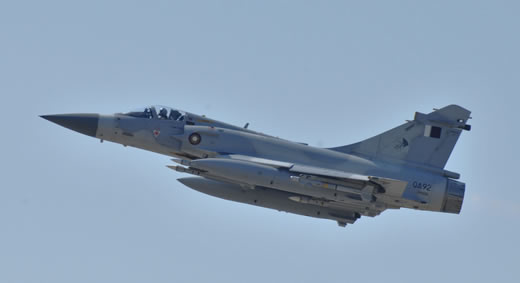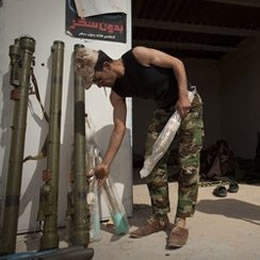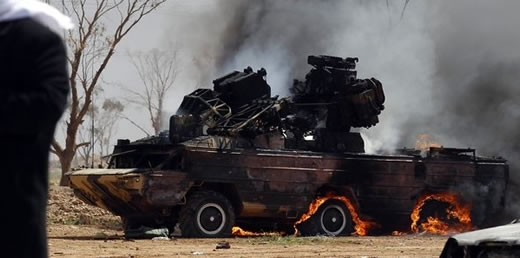
The UN mandated operation against Libya has evolved in recent days into three parallel efforts – the enforcement of the ‘no fly zone’ over the country, ground attacks supporting and stimulating a rebel campaign repelling Gaddafi supporters, and a ‘drying’ Gaddafi’s military sustainment by enforcing a naval blockade, preventing reinforcements, weapons and ammunition shipments from reaching Libyan ports. In recent days NATO agreed to take over the enforcement of the No Fly Zone and UN mandated naval blockade under ‘Operation Unified Protector’, enforcing an arms embargo on Libya, an effort aiming to prevent arms being delivered to Libya from the Mediterranean. Canadian air force Lt. Gen. Charles Bouchard was assigned lead the operation. The NATO alliance is expected to take control of the operation by March 30.

Under ‘Unified protector’, NATO maritime forces will conduct operations to monitor, report and, if needed, interdict vessels suspected of carrying illegal arms or mercenaries. This will be done in close co-ordination with commercial shipping and regional organizations. The blockade could potentially assist in reducing the flow of illegal immigrants reaching accross the Mediterranean from Libya to Southern Italy. The flow of immigrants is expected to increase after the fall of the former regime. Since Thursday, coalition raids appear to have intensified and became more effective.
Rebel sources claim that after Libyan Army officers who joined the rebellion established contact with the coalition, improving coordination of support operations. Backed by the coalition support, Libyan rebels continued their rapid advance west, have captured today (March 27) the oil terminals of Ras Lanuf, about 210 km west of the city of Ajdabiya, which fell to the ebels a day earlier. The next objective on the rebels advance is Sirte, Gaddafi’s home-town stronghold. Coalition air forces has conducted extensive raids on the coastal road between Ajdabiya and Sirte.

Rebels are not the only element celebrating on the chaos in Libya. Islamist elements affiliated with al-Qaeda in the Maghreb (AQIM) seized Libyan Army weapons stockpiles abandoned near Benghazi and other areas taken by Libyan rebels to obtain weapons they did not have access to in the past.
According to a report in Jeune Afrique, quoting Chad’s President Idriss Deby Itno. The magazine quotes the president as “100 per cent sure” of his assertion. He said the weapons, including man-portable surface-to-air missiles (MANPADS) were smuggled into AQIM sanctuaries in Tenere, a desert region of the Sahara that stretches from northeast Niger to western Chad. The extremist Islamic movement operates mainly in Algeria, Mauritania, Mali and Niger, where it has attacked military targets and taken civilian hostages, particularly Europeans, some of whom it has killed. Col. Gaddafi accused AQIM to be the driving force behind the rebelion.
On March 19, 2011, following UN Security Council resolution 1973 the U.S. led coalition started out small, but quickly established the no-fly zone, obtained maritime superiority, put the embargo in place, interdicted ground forces, suppressed enemy air defenses and put humanitarian operations in place. In the recent days, the operation evolved a series of strike campaign against the Libyan ground forces. “This is a multi-phased operation. Our coalition partners are assuming more and more responsibility.” Navy Rear Adm. Gerard P. Hueber said.
Libyan forces have not used surface-to-air missiles in four days, he added. The airstrikes have rendered Libya’s air defense ‘severely degraded or destroyed’ the admiral said. In the planning, Libyan air force and air defenses were not taken easy. U.S. Navy Chief of Operations, Adm. Gary Roughead said he was particularly concerned about Moammar Gaddafi’s integrated air and missile defense system. Though the system was old, he said, “I don’t take any of that for granted. If someone is going to put a missile in the air, you don’t say, ‘Oh, it’s an old one, I’ll worry about it later.’”


While Libyan air and air defense activity were taken down, forces loyal to Gaddafi continue to advance on Benghazi on Libya’s northeastern coast, and are not pulling back from Misurata on the northwestern coast and Ajdabiya, just south of Benghazi. “We are now applying sustained, unrelenting pressure on the Libyan Armed Forces.” Said RAF Commander of the air operations over Libya, Air Vice-Marshal Greg Bagwell. “Their air force no longer exists as a fighting force, and its integrated air defense system and command and control networks are severely degraded to the point that we can operate over [Libyan] airspace with impunity.” Bagwell continued, “We have the Libyan ground forces under constant observation, and we attack them whenever they threaten or attack civilians or population centers.”
With the arrival on Monday night (March 21) of the RAF Tornado GR4 jets at Gioia del Colle air base, all UK fast jets currently assigned to Operation Ellamy were in place. The presence of the Tornados together with the Typhoon fighters means that the UK can strike both air and ground targets as required, as part of the co-ordinated international operation. Coalition air forces continue to pound Libyan ground. On the night of the 23-24 March ten aircraft of the Air Force and Navy were engaged in night strikes against Libyan forces grouped at the remote airfield Al-Jufra, 250 km south in Benghazi. The French fighters included two Mirage 2000D and two naval Rafales, they engaged their targets with SCALP cruise missiles. Tornado GR4s launched from Gioia del Colle that night engaged Libyan ground forces with Brimstone anti-tank guided missiles, destroying armored vehicles and artillery units near the city of Ajdabiya.
According to U.S. director of the Joint Staff Navy Vice Adm. William E. Gortney, other strikes went after Gadhafi regime armored forces outside Ajdabiyah. The coalition also hit more command and control facilities in and around Tripoli and launched 16 more Tomahawk strikes against targets that included Scud missile garrisons in Tripoli and air defense systems around Sabha. 96 of the 153 sorties flown in the past 24 hours were strike missions, “Slightly more than half of those strike missions were flown by U.S. pilots,” the admiral said.
Over the weekend (March 25) Qatari Air Force and UAE Air Forces deployed aircraft to join the coalition forces. Qatari Mirage 2000-5 joined the coalition air forces flying the no-fly zone enforcement missions. On Sunday (March 27) Twelve F-16s and Mirage 2000s from the UAE have landed at the Italian base of Decimomannu on the island of Sardinia.“Partner nations are taking on more missions, and the division of labor between U.S. and partner nations has evened out” admiral Gortney said. “As operations continue, the United States will fly most refueling, surveillance, information operations and jamming missions,” he added.



















